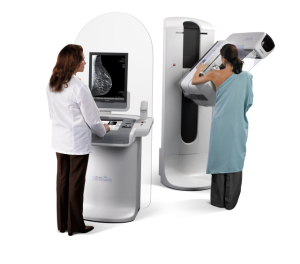by
Olga Deshchenko, DOTmed News Reporter | February 11, 2011
Hologic Inc. said Friday it received U.S. Food and Drug Administration approval for its Selenia Dimensions digital breast tomosynthesis system, the first such device to be sold in the U.S.
According to Hologic, the 3-D breast scanning technology is superior to conventional 2-D digital mammography because it can detect cancerous masses hidden by overlying breast tissue.
"Physicians can now access this unique and innovative 3-D technology that could significantly enhance existing diagnosis and treatment approaches," Dr. Jeffrey Shuren, director of the FDA's Center for Devices and Radiological Health, said in prepared remarks.
The potential of 3-D breast imaging technology has been generating a buzz among radiologists for months. "Right now, we're looking at the forest and sometimes what we need to do, is look at the tree because that's where you have pathology," Dr. Martine Backenstoss, section chief of mammography with Rochester General Hospital in New York,
told DOTmed News in November.
"Certainly the intent of 3-D images is to reveal the inner architecture of the breast, which you can't always see satisfactorily on single plane images because you have so much superimposed fibroglandular tissue," she added.
Hologic's tomosynthesis system has been on the verge of FDA's approval since last year. In 2010, the company received an "approvable" letter from the FDA for the Selenia Dimensions unit, which meant the agency had to still inspect Hologic's manufacturing plant before issuing final approval.
In a note about its approval of the system, the FDA said it examined the results of two studies, in which radiologists reviewed more than 300 2-D and 3-D images. "In both studies, radiologists viewing both the 2-D and 3-D images obtained a 7 percent improvement in their ability to distinguish between cancerous and non-cancerous cases as compared to viewing 2-D images alone," according to the FDA.
The agency did point out that the combination of Selenia's 2-D and 3-D images about doubled the radiation dose received by patients but said it improved the accuracy of tumor detection and decreased the number of women called back for a diagnostic workup.
"There is uncertainty for radiation risk estimates; however, the increase in cancer risk from having both a 2-D and 3-D exam is expected to be less than 1.5 percent compared to the natural cancer incidence, and less than 1 percent compared to the risk from conventional 2-D mammography," the FDA said.
